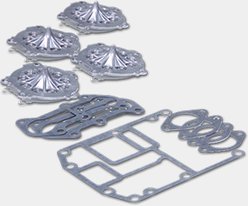Mercury® outboards are built to withstand the highly corrosive marine environment. They feature corrosion-resistant alloys, a multi-layer paint system and corrosion-resistant materials as a first line of defense. By following a few easy additional steps, you can do even more to keep the effects of corrosion at bay, especially if you boat in saltwater.
1. Flush First
Mercury recommends that an outboard operated in saltwater be flushed and rinsed after each use. Flushing clears the cooling system of corrosive saltwater, and rinsing removes salt residue before corrosion can begin. Flushing after use in brackish, polluted or very silty freshwater is also recommended. This is easy to do and is an important step to inhibit corrosion.
Most late-model Mercury outboards from 70hp to 400hp feature Flush Connect, a dedicated flush fitting designed to accept a standard garden hose. The Flush Connect fitting is in the lower cowl. Consult your Mercury operation, maintenance and installation manual for the location of the flush fitting on your outboard model, and specific flushing instructions for your engine. The engine may be flushed when the boat is on a trailer or in the water.
In the video below, Mercury Pro Team member Brian Latimer demonstrates how easy it is to attach a hose to the Flush Connect fitting on his Mercury 250hp Pro XS® outboard.
A flush muff device can be used to flush an outboard that is not equipped with a hose fitting. The muff fits around the gearcase and covers the cooling water inlets with rubber cups. A garden hose attached to the muff supplies freshwater. Follow the instructions in your outboard’s manual to use the flush muff.
2. Then Rinse
After flushing, it’s good practice to use your hose to rinse salt residue from the exterior of an outboard. Rinse the outboard cowl, mounting bracket and trim ram area. Always lower the outboard to a vertical position before rinsing the cowl. Rinsing the cowl while the outboard is tilted can allow water to enter the air intake at the rear of the cowl.
Next, remove the cowl and the plastic flywheel cover and carefully rinse salt residue from the powerhead. Do not use high-pressure water or a spray nozzle, which can force water into electrical connections. Just let the water flow from the hose and take care to keep water away from the engine air intake and the alternator. Also rinse off the cowl latches, then allow the engine to dry.
Once the outboard powerhead is dry, apply a light coat of Mercury Corrosion Guard Engine Protect to under-cowl areas, taking care to keep Engine Protect away from the air intake, alternator, and belts and pulleys. Corrosion Guard Engine Protect forms a water-resistant barrier on painted and non‑painted metal surfaces. The clear film coating quickly dries to the touch and won’t become sticky over long-term use. Spray Mercury Corrosion Guard Heavy Duty on the outdrive, gearcase, tilt and trim motor, exposed electrical connections, and other surfaces that operate in the water. Avoid covering anodes.
You can also use Mercury All-in-One Spotless Shine to remove unsightly water spots from fiberglass, metal, plastic and rubber surfaces, which helps keep your boat and engine shining like new.
Flushing and rinsing after use in saltwater is the best way to prevent future corrosion issues. See a Mercury Authorized Dealer for Mercury engine-care products and expert advice on outboard maintenance.

















